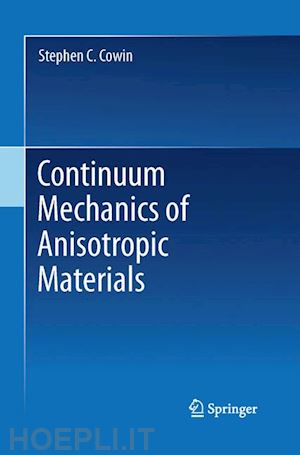
Questo prodotto usufruisce delle SPEDIZIONI GRATIS
selezionando l'opzione Corriere Veloce in fase di ordine.
Pagabile anche con Carta della cultura giovani e del merito, 18App Bonus Cultura e Carta del Docente
Chapter 1. Introduction
Chapter 2. Mechanical modeling of materials
2.1 Introduction
2.2 Models and the real physical world
2.3 Guidelines for modeling objects and solving mechanics problems
2.4 The types of models used in mechanics
2.5 The particle model
2.6 The rigid object model
2.7 The deformable continuum model
2.8 Lumped parameter models
2.9 Statistical models
2.10 Cellular automata
2.11 The limits of reductionism
2.12 References
Appendix 2A Laplace transform refresher
Appendix 2B First order differential equations
Appendix 2C Electrical analogs of the spring and dashpot models
Chapter 3. Basic continuum kinematics
3.1 The deformable material model, the continuum
3.2 Rates of change and the spatial representation of motion
3.3 Infinitesimal motions
3.4 The strain conditions of compatibility
Chapter 4. Continuum formulations of conservation laws
4.1 The conservation principles
4.2 The conservation of mass
4.3 The state of stress at a point
4.4 The stress equations of motion
4.5 The conservation of energy
Chapter 5. Formulation of constitutive equations
5.1 Guidelines for the formulation of constitutive equations
5.2 Constitutive ideas
5.3 Localization
5.4 Invariance under rigid object motions
5.5 Determinism
5.6 Linearization
5.7 Coordinate invariance
5.8 Homogeneous versus inhomogeneous constitutive models
5.9 Restrictions due to material symmetry
5.10 The symmetry of the material coefficient tensors
5.11 Restrictions on the coefficients representing material properties
5.12 Summary of results
5.13 Relevant literature
Chapter 6 Modeling material symmetry
6.1 Introduction
6.2 The representative volume element (RVE)
6.3 Crystalline materials and textured materials
6.4 Planes of mirror symmetry
6.5 Characterization of material symmetries by planes of symmetry
6.6 The forms of the 3D symmetric linear transformation A
6.7 The forms of the 6D symmetric linear transformation
6.8 Curvilinear anisotropy
6.9 Symmetries that permit chirality
6.10 Relevant literature
Chapter 7. Four linear continuum theories
7.1 Formation of continuum theories
7.2 The theory of fluid flow through rigid porous media
7.3 The theory of elastic solids
7.4 The theory of viscous fluids
7.5 The theory of viscoelastic materials
7.6 Relevant literature
Chapter 8 Modeling material microstructure
8.1 Introduction
8.2 The representative volume element (RVE)
8.3 Effective material parameters
8.4 Effective elastic constants
8.5 Effective permeability
8.6 Structural gradients
8.7 Tensorial representations of microstructure
8.8 Relevant literature
Chapter 9. Poroelasticity
9.1 Poroelastic materials
9.2 The stress-strain-pore pressure constitutive relation
9.3 The fluid content-stress-pore pressure constitutive relation
9.4 Darcy’s Law
9.5 Matrix material and pore fluid incompressibility constraints
9.6 The undrained elastic coefficients
9.7 Expressions of mass and momentum conservation
9.8 The basic equations of poroelasticity
9.9 The basic equations of incompressible poroelasticity
9.10 Some example isotropic poroelastic problems
9.11 An example: the unconfined compression of an anisotropic disc
9.12 Relevant literature
Chapter 10 Mixture
10.1 Introduction
10.2 Kinematics of mixtures
10.3 The conservation laws for mixtures
10.4 A statement of irreversibility in mixture processes
10.5 Donnan equilibrium and osmotic pressure
10.6 Continuum model for a charged porous medium; the governing equations
10.7 Linear irreversible thermodynamics and the four constituent mixture
10.8 Modeling swelling and compression experiments on the intervertebral disc
10.9 Relevant literature
Chapter 11. Kinematics and mechanics of large deformations
11.1 Large deformations
11.2 Large homogeneous deformations
11.3 Polar decomposition of the deformation gradients
11.4 The strain measures for large deformations
11.5 Measures of volume and surface change in large deformations
11.6 Stress measures
11.7 Finite deformation elasticity
11.8 The isotropic finite deformation stress-strain relation
11.9 Finite deformation hyperelasticity
11.10 Incompressible elasticity
11.11 Relevant literature
Chapter 12. Plasticity Theory
12.1 Extension of von Mises criterion to anisotropic materials
12.2 Yield criteria for pressure sensitive anisotropic materials
12.3 Some particular deformation characteristics exhibited by granular materials (dilatancy/contractancy, anisotropy, hardening/softening, and shear localization).
12.4 Dilatant double shearing kinematics
12.5 Evolution equations for the material parameters
12.6 Numerical biaxial compression test of anisotropic granular materials
12.6 Numerical triaxial compression test of anisotropic granular materials
12.7 Plasticity theories for crystalline materials
Appendix A. Matrices and tensors
A.1 Introduction and rationale
A.2 Definition of square, column and row matrices
A.3 The types and algebra of square matrices
A.4 The algebra of n-tuples
A.5 Linear transformations
A.6 Vector spaces
A.7 Second rank tensors
A.8 The moment of inertia tensor
A.9 The alternator and vector cross products
A.10 Connection to Mohr’s circles
A.11 Special vectors and tensors in six dimensions
A.12 The gradient operator and the divergence theorem
A.13 Tensor components in cylindrical coordinates











Il sito utilizza cookie ed altri strumenti di tracciamento che raccolgono informazioni dal dispositivo dell’utente. Oltre ai cookie tecnici ed analitici aggregati, strettamente necessari per il funzionamento di questo sito web, previo consenso dell’utente possono essere installati cookie di profilazione e marketing e cookie dei social media. Cliccando su “Accetto tutti i cookie” saranno attivate tutte le categorie di cookie. Per accettare solo deterninate categorie di cookie, cliccare invece su “Impostazioni cookie”. Chiudendo il banner o continuando a navigare saranno installati solo cookie tecnici. Per maggiori dettagli, consultare la Cookie Policy.